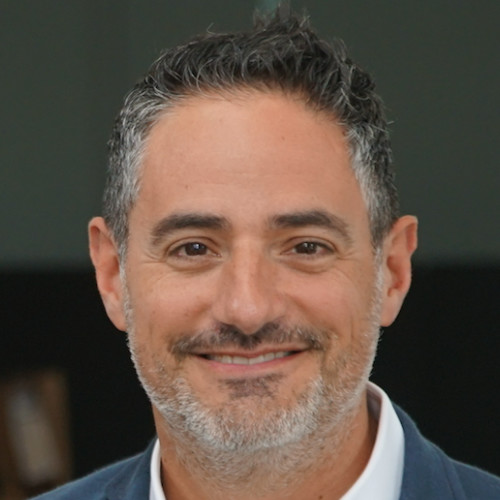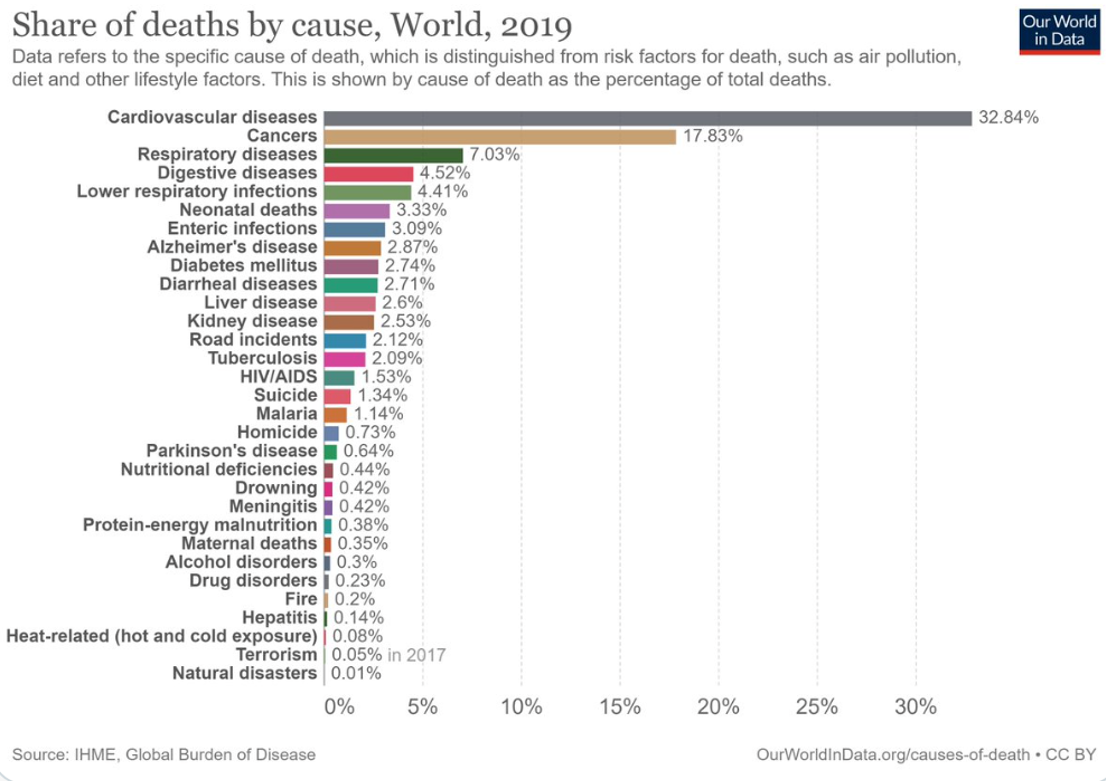

Amid the 2024 elections, Pulse on Political Narratives is a first-of-its-kind, AI-powered study identifying what candidates across the political spectrum are saying about issues that matter to companies and their stakeholders.

This graphic below recently caught my eye. It’s a breakdown of how we die, tracked during the first twenty years of the 21st century. Heart attacks, cancers, and lung disease top the list by a wide margin.
At the bottom of the chart, natural disasters, terrorism, and death from extreme heat or cold barely register. Since the study ended, the most significant deviation from the norm is COVID. It is one of the top four causes of death.
The graphic caught my eye not so much because of death but fear. Fear of the unknown. Of danger. And in the context of this post, fears stoked in the media.

Think about the dichotomy of the chart—the inverse of things to be mindful of and what’s doggedly menacing in our feeds.
Our news feeds are thick with hyperbolic dread. Disasters. Terrorism. Climate hell. Culture wars. The world feels more dangerous and divided. Question is, do unrelenting doom scrolls accurately represent daily life?
Our existence is now, by and large, mediated. What’s mediated and why is worth reflection. What is news? Who decides what’s worthy of reporting? How does it impact culture and personal well-being?
Much of what’s presented as news isn’t. The watered-down, Internet-influenced definition is new content. Hard news. Soft news. Ideological news. Entertainment posing as news. Updates in newsfeeds masquerading as news.
Professionally speaking, journalistic standards still determine what is covered by global news organizations. In 2017, Monika Bednarek and Helen Carole did exhaustive research on the “construction of newsworthiness.”
Affiliated with Oxford and the Reuters Institute for the Study of Journalism, the pair analyzed the archives of twelve international newspapers and twenty-two international news organizations’ websites, Facebook, and Twitter accounts.
The dichotomy of news ethic (news organizations’ stated editorial mission) and orientation (news organizations’ news judgment) is telling.
In its editorial mission, The New York Times speaks truth, fairness impartiality, transparency, integrity, accuracy, and independence. The BBC adds intent like focus on audience, quality and value for money, diversity, and team spirit. The Associated Press is about format and distribution; their stories must be “transmitted in many ways.”
According to Bednarek/Carole’s research, newsworthiness reflects none of these objectives. Story selection and presentation are decided by five factors:
What is timely.
What is proximate.
What is superlative.
What is unexpected.
And what is negative.
The higher the ratio of these elements, the greater the chance the event in question becomes news.
These are the psychological drivers of the attention gold rush. This is the gateway to monetizing news and digital content.
Media values mirror human nature. We desire a sense of control. We’re susceptible to fear. Danger intrigues us.
Criminal Minds is the most-viewed TV show. Lucifer and the Squid Games are top Netflix’s originals. Call of Duty: Vanguard topped the gaming charts in 2021. The “fight for democracy” is a cash machine. Fox News wins the prime-time cable wars by a wide margin.
Arresting media is cloaked in darkness. And that includes the news.
Alain de Botton wrote in The News: A Users Manual, that outer turmoil is precisely what we need to foster a sense of inner calm. We check the news to convince ourselves we’re OK. In actuality he says, facing gruesome consequences of daily living invite us to “feel sane and blessed by comparison.”
Other writers including Rolf Dobelli see it differently. Dobelli was among the first to say “news is to the mind what sugar is to the body.” He says it leads to fear and aggression. It hinders your creativity and ability to think deeply. It has no value whatsoever. I found it ironic he wrote his essay, News is Bad for You, for The Guardian, one of the world’s top newspapers.
In June 2019, Tristian Harris, founder of the Center for Humane Technology, testified to the U.S. Senate. Harris, a former student of Stanford’s Persuasive Technology Lab was Design Ethicist at Google. He knows the hazards of “engagement” as the primary incentive for media.
Harris became known for saying in his testimony that:
“Each time technology companies go lower into the brain stem, it takes a little more control of society. It starts small. First, to get your attention, I add slot machine “pull to refresh” rewards which create little addictions. I remove stopping cues for “infinite scroll” so your mind forgets when to do something else. But then that’s not enough.”
“The next step of the attention economy is to compete on algorithms. To maximize watch time, it tilts the entire ant colony of humanity toward crazy town.”
This now includes murderous crazy for any and all to see. On platforms, news-generating content amplifies destructive intent. The search for what’s new, demonstrated through keywords, includes shreds, dismantles, rips, confronts, destroys, and hates.
Toxicity in the news and public forums became so bad, that Yancey Strickler likened the retreat to safe havens as The Dark Forest Theory of the Internet. In a defining essay on Internet culture Strickler said:
In response to the ads, the tracking, the trolling, the hype, and other predatory behaviors, we’re retreating to our dark forests of the internet, and away from the mainstream.
Dark forests like newsletters and podcasts are growing areas of activity. As are other dark forests, like Slack channels, private Instagrams, invite-only message boards, text groups, Snapchat, WeChat, and on and on.
These are all spaces where depressurized conversation is possible because of their non-indexed, non-optimized, and non-gamified environments. The cultures of those spaces have more in common with the physical world than the internet.
The desire for comfort and agenda-free engagement helps explain how TikTok ate the Internet. According to research co-authored with Nielsen, users cited the joy of using the app, along with general positivity, and unfiltered perspectives on the community as to why it’s the Internet’s top app.
Globally, an average of 59 percent of users feel a sense of community when they are on TikTok, while 77 percent of users say TikTok is a place where people can express themselves openly. You also see large followings opting into emotional resonance and comfort in the most popular Reddit forums. r/funny, r/gaming, and r/aww are among the largest subreddits (aww features puppies, bunnies, and babies and has 31MM subscribers). r/MadeMeSmile has the most engagement, with over 100M post votes.
Dark forests and comfort zones also apply to the news. People are opting out of fear-mongering in large numbers.
A recent media triumph is The Morning Brew. The light-hearted newsletter has 4 million subs, expanding into a multidimensional media operation (for context cable TV’s top prime draw, Tucker Carlson attracts on average 3.2 million viewers).
Following the success of John Krasinsky’s Some Good News, other “health-conscious” media outlets such as Goodable, are gaining popularity. And turning back to Reddit, 16 million strong follow r/UpliftingNews in their feeds.
My recent escape route, albeit a little less “comforting,” is InboxWorld, a platform to find the best online newsletters. I’ve found the best writing on topics of interest to me, independent of media or political agendas.
InboxWorld features the same categories you’d find in the traditional press. The writers are independent. Their brands are unbundled, beyond any masthead. The incentives to attract readers are based on interest and community over ad clicks and engagement at all costs.
For me, InboxWorld feels like the future of the newsstand. It’s an off-ramp to fantastical reporting that bears little resemblance to my world or interests.
The slow return to a hybrid public-private media presents infinite options to build personal information spaces. Faced with infinite information infinity, a new world of news pickers now report on the Internet and interests of concern to them.
They’re people like us who interpret developments, implications, and actions to consider. Global news organizations are far from the only game in town.
Whether that’s a good or bad thing, only time will tell.
This article was originally posted on Media Genius.


Amid the 2024 elections, Pulse on Political Narratives is a first-of-its-kind, AI-powered study identifying what candidates across the political spectrum are saying about issues that matter to companies and their stakeholders.